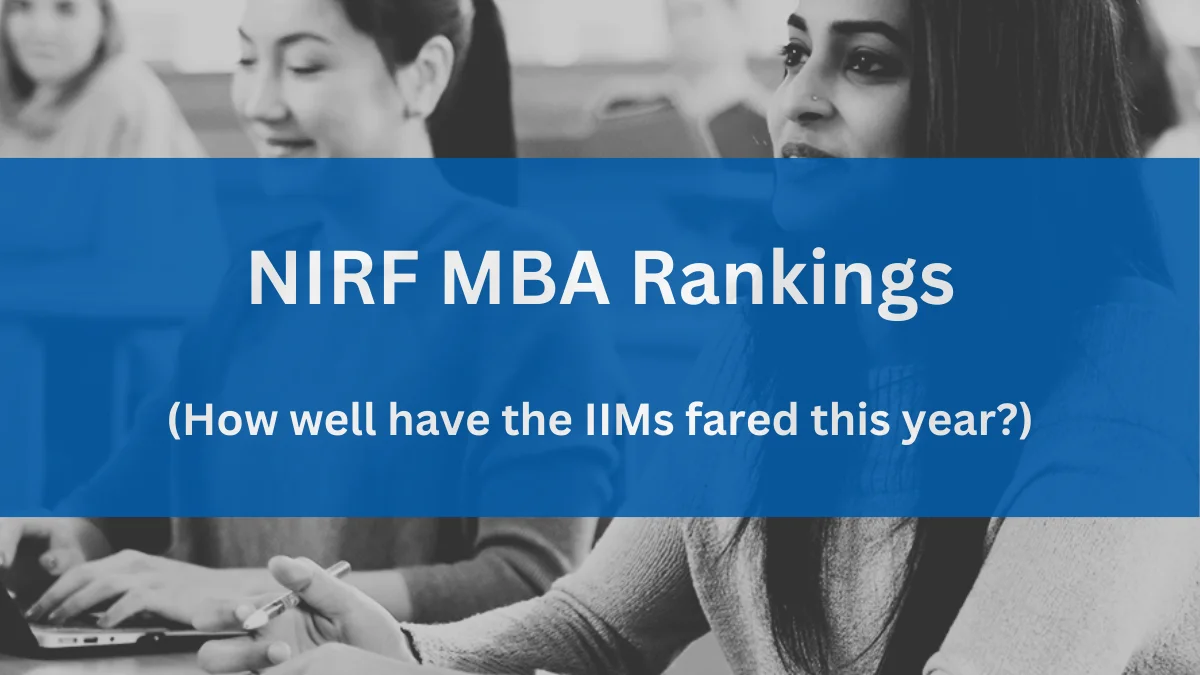NIRF MBA Rankings 2024: Top 20 B-Schools in India
The NIRF MBA ranking (National Institute Ranking Framework) MBA was released on 12th August 2024. In this blog, we have explained the parameters used to rank colleges as well as the key trends that frame them. You’ll see which B-Schools gained the most ground and why. We’ll also discuss how to use these rankings to inform your college preferences in the proper manner. Lastly, we’ll compare the NIRF MBA rankings with other MBA ranking lists: Financial Times, QS, and our very own list at IMS to enable MBA aspirants to decide on selecting their B-schools to do their MBA from.

Please note:
- The NIRF ranking considers only those institutes that have participated in the ranking.
- The NIRF only ranks B-Schools up to rank 100.
- In 2024, 876 B-schools participated in the NIRF ranking. (There are more than 3000 AICTE-approved B-schools in India.)
As seen below, the brand of the IIMs ensures that they corner sizable ranks within the top 20 best MBA programs in India (there are currently 21 IIMs in India). The oldest IIMs are, of course, right at the top of the NIRF MBA Rankings. Most IIMs rank very well because they end up with the best placement outcomes, the best companies come on campus, and they have an almost 100% placement record. However, the NIRF ranking parameters are different; research, publications, and a very healthy faculty-student ratio also play a key role. 10 of the top 20 ranks are garnered by the IIMs, while other great private institutes such as XLRI, IIFT, SP Jain, and MDI round up the top 20.
NIRF MBA rankings 2024 – The top 20 MBA colleges in India
This list shows that while the IIMs are known for their placement record and brand, they also do very well on other parameters, including Teaching, Quality of Faculty, Publications and Research, Peer Review, Outreach, and Inclusivity, which are used as ranking parameters in the NIRF.
Read More – Top MBA Colleges in India – As ranked by the experts at IMS
As seen below, the stellar reputation of the IIMs, especially the old ones, ensures their position at the top. With some of the most employable graduates, MBB, Big 4, and Fortune 500 companies flock to these colleges for placements. But there are a few surprises in store, too.
Read More – CAT Previous Year Question Papers With Video Solutions
| NIRF MBA Ranking | Institute Name | Institute Location |
| 1 | IIM Ahmedabad | Ahmedabad |
| 2 | IIM Bangalore | Bangalore |
| 3 | IIM Kozhikode | Kozhikode |
| 4 | IIT Delhi | Delhi |
| 5 | IIM Calcutta | Calcutta |
| 6 | IIM Mumbai | Mumbai |
| 7 | IIM Lucknow | Lucknow |
| 8 | IIM Indore | Indore |
| 9 | XLRI | Jamshedpur |
| 10 | IIT Bombay | Mumbai |
| 11 | MDI | Gurgaon |
| 12 | IIM Rohtak | Rohtak |
| 13 | SIBM | Pune |
| 14 | IIM Raipur | Raipur |
| 15 | IIFT | Delhi |
| 16 | IIT Madras | Chennai |
| 17 | IIM Ranchi | Ranchi |
| 18 | IIT Roorkee | Roorkee |
| 19 | IIT Kharagpur | Kharagpur |
| 20 | SPJIMR | Mumbai |
Read More – Top Tier 2 MBA Colleges in India
NIRF MBA rankings – What are the parameters that NIRF uses?
The NIRF uses the following Parameters. We hope this will help you compare B-Schools based on specific parameters that are important to you to come to the right decision.
| NIRF MBA Rankings Parameters | Marks | Weightage |
| Teaching, Learning & Resource (TLR) | 100 | 0.30 |
| Research, Professional Practice & Collaborative Performance (RPC) | 100 | 0.30 |
| Graduation Outcome (GI) | 100 | 0.20 |
| Outreach and Inclusivity (OI) | 100 | 0.10 |
| Perception (PR) | 100 | 0.10 |
Read More – MBA from IITs – Admission, eligibility, fees, placements
Teaching, Learning, and Resources
The first parameter in the NIRF MBA rankings deals with the quality of education being imparted to the students and the resources available on the campus to improve student learning further. The number of teachers, their qualifications, the laboratories, research facilities, libraries, and other academic units come under this parameter. But it doesn’t end there. Holistic learning doesn’t come with just academics; it requires extracurricular activities and spaces to practice them. It should come as no surprise that the NIRF also places great emphasis on the sports and recreational facilities available on campus.
Research and Professional Practice
Apart from the teaching aspect, colleges are also fertile grounds for innovation and research. Professors and lecturers are expected to further their own practice while fulfilling their social responsibility of expanding the knowledge corpus through diligent research, IPR generation, patenting etc. In fact, even students should be encouraged to partake in research studies to put their theoretical knowledge to practical use. The second NIRF MBA rankings metric measures just that.
Graduation Outcomes
Indian educational institutions have witnessed a palpable shift in their approach to education. They’ve moved away from rote learning and moved towards outcome-based education that yields net positive results for the students. This metric essentially boils down to how many students graduate on time within the course they signed up for. The NIRF also adds another dimension to this metric by giving a score to the number of PhD students graduating every year.
Read More – MBA vs PGDM – Which is better?
Outreach and Inclusivity
Colleges are bastions of forward-thinking ideologies that should foster inclusive growth for people from all backgrounds. This parameter measures the institution’s effort to enlarge its circle of influence by bringing economically, socially, and physically challenged students under its ambit. NIRF places 20% of its overall weightage on the score colleges achieve in this parameter, underlining how critical it is for higher education institutions to play their role.
Peer Perception
Institutional outreach to bring in experts from various fields, expand its industry connect, and ensure its students have access to the best possible opportunities depends heavily on how it is perceived by its industrial, academic, and social peers. Peer perception is a metric conceptualised by the NIRF to incentivise colleges to work on improving their brand value.
Read More – CAT Cutoffs – How much do you need to score to get into the top colleges?
NIRF MBA rankings – Key trends
While a cursory glance doesn’t reveal much movement, we dived deeper than the surface to uncover insights.
- Quite a few B Schools showed an improvement in their rank by improving across all major parameters. IIFT jumped 12 spots to climb to the 15th rank on the back of better research output, while IIM Nagpur reached the 31st rank based on the score it received on the TLR and RP parameters.
- MICA and IRMA improved their rank by five positions each. MICA moved up to 32nd with more quality research publications. IRMA, India’s top rural management school, entered the top 50 at the 49th position, as it saw better peer perception scores and more research publications in reputed journals.
- SIBM Pune jumped four places to the 13th rank due to the higher score it received in the Research and Professional Practice metric.
- Institutes such as GIM, TAPMI, KJ Somaiya, Welingkar, IMT, and IMI witnessed drops in their rank due to a decline in their Peer Perception scores.
- IIM Trichy and IIM Udaipur also saw their ranks drop, pushing them out of the top 20 NIRF MBA rankings. They witnessed a decline in their Peer Perception scores and research performance.
Read More – CAT Score vs Percentile – What score do you need to score 90%ile?
NIRF MBA rankings – How do the top colleges fare in other lists?
Not all lists are the same; each list uses different parameters and data points to create their rankings. Based on the parameters you value the most, score up the colleges to better reflect your priorities. Here, we will compare the NIRF MBA rankings to those of QS and Financial Times, along with the insider IMS rankings.
| Institute Name | NIRF MBA Rankings | QS MBA Rankings | FT MBA Rankings | IMS MBA Rankings |
| Indian School of Business | NA | 86 | 31 | A1 |
| IIM Ahmedabad | 1 | 60 | 41 | A1 |
| IIM Bangalore | 2 | 53 | 47 | A1 |
| IIM Calcutta | 5 | 65 | 67 | A1 |
| IIM Lucknow | 7 | NA | 85 | A1 |
| XLRI | 9 | NA | 99 | A1 |
Read More – Top PGDM Colleges in India
As you will note, there is a difference in the Rank of the institute depending on the Ranking body. While QS ranks IIM Bangalore the highest, FT ranks ISB Hyderabad as the best in India. On the other hand, the NIRF MBA ranking considers IIM Ahmedabad to be at the top. Another point that comes to light when one glances at the table above is the variation in the ranking of ISB. There’s a difference of 54 places between its 31st rank in the FT list and 86th rank in the QS list.
This usually occurs because rankings tend to use varied parameters as well as the weight they assign to each parameter. FT ranking even includes carbon footprint as a parameter, a metric on which many Indian schools don’t fare as well as their international peers. QS places a greater emphasis on diversity, both gender and international, another factor that does not necessarily put Indian schools in the best light. On the other hand, when metrics such as Value for Money, Career Progress, and Weighted Salaries are used, Indian schools don’t just fare as well but even beat some of the most popular schools abroad. We must also bear in mind that international MBA lists like the FT and QS are global rankings and have some of the best global schools like Harvard, Wharton, Stanford, INSEAD and London Business School in their list.
NIRF MBA rankings – How to use these rankings to choose the right MBA college for yourself?
While the rankings do shed light on great colleges, issues do occur when you try to compare two very good institutes. For instance, in a comparison between IIM A, B, C L, and ISB, it would be better to also consider some other parameters that may not be included in the Rankings.
- RoI – Pursuing an MBA degree from a top B School is a substantial investment of time and money. Most colleges have substantial fees and other expenses. However, a good MBA program would be one that may seem to have a high upfront cost (fee) it will also be the one that enables a strong professional career and super returns down the line, enabling you to not only recover the costs but also build equity for a large part of your career.
- Past Students – Alumni reviews could be a good source of verified BSchool information. However, this may be biased too. You can connect with some Alumni to get feedback on the institution. This effort should reveal several insights about your target MBA college in India.
- Placement data – One truly valuable source of understanding your institute and its outcomes is its own websites. The best institutes will always be willing to share that data with you. Apart from salaries, placement data like the functions the students were placed in, the companies on campus, their summer internship statistics, etc., could give a great insight into the appropriateness of the institution.
Read More – CAT Syllabus – Topic-wise weightage
For more detailed overviews of each ranking, you can visit the official sites – QS MBA Rankings 2025, FT MBA Rankings 2024, NIRF India Rankings 2024 – Management, and IMS Top MBA Colleges in India.
Also, learn more about the NIRF MBA rankings parameters here – NIRF Booklet.









